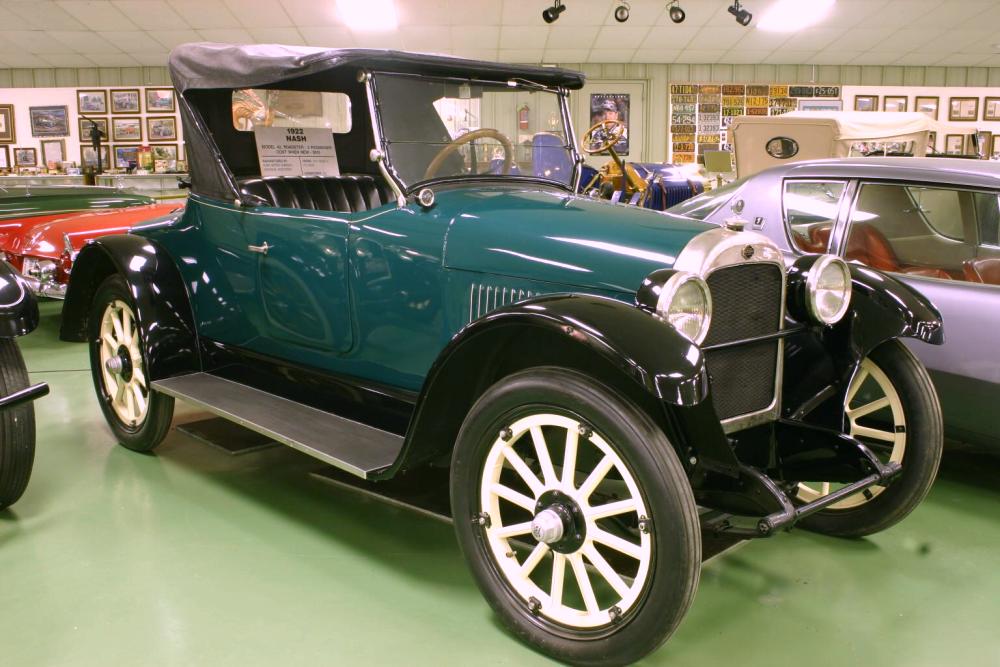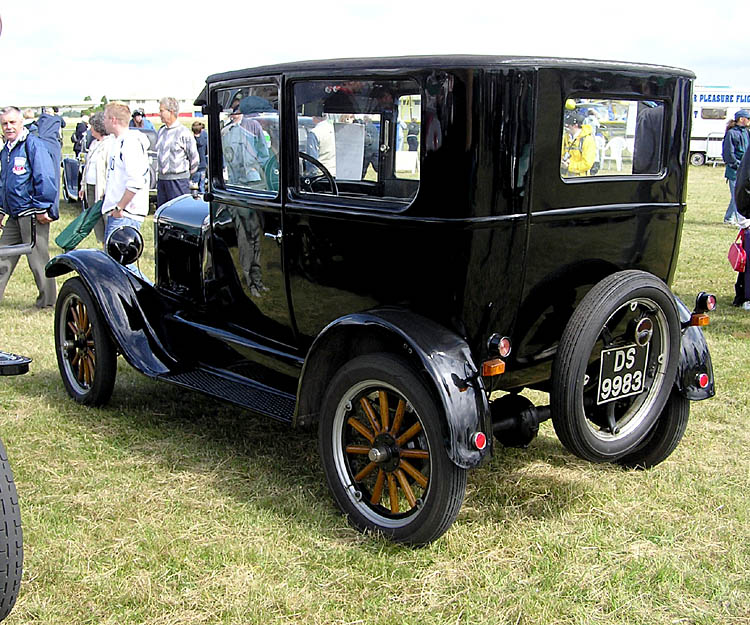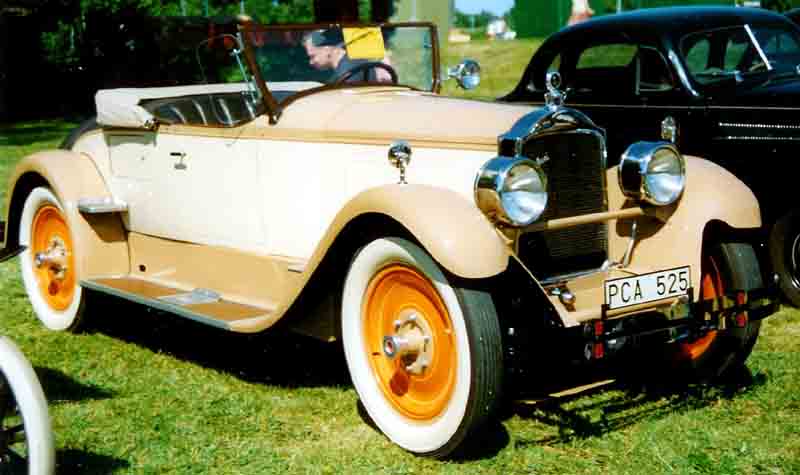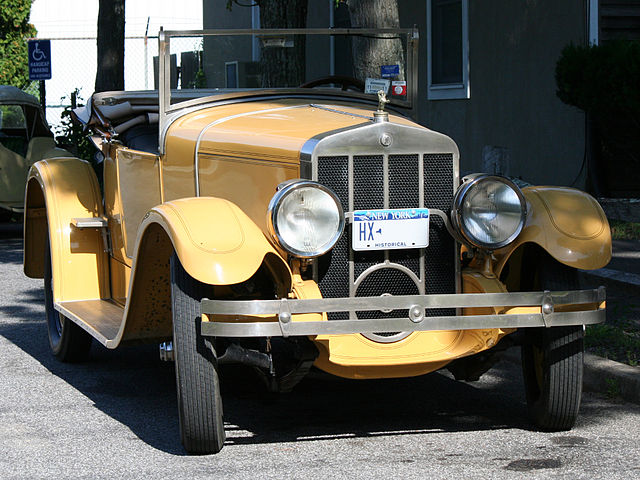Automobiles have changed a lot since the 1920s. The car industry was very good in the 1920s. There were many new types of cars. In the beginning of the 1920s, a lot of soldiers who fought in World War I bought cars when they returned home from the war. People started to see that having a car would make traveling much easier. Soon almost every American family had a car. Ford was the big car maker but other companies were also big at the time. Ford cars were popular because they did not cost much money. During the 1920s, car makers made a lot of money.
Monstrous American Car Spotter's Guide 1920-1980
Monstrous American Car Spotter's Guide 1920-1980
Chrysler Imperial E80 Touring 1926
1926.Chrysler.imperial.roadster
------------------------------------------------------------------------------------------------------------- The "80" in the code referred to the fact the car was capable of 80 miles an hour. The number in the model code for all Chryslers of this period referred to the top speed of that particular series.
1929 Duesenberg
Prices began at $6,500
Although the Duesenberg brothers were world-class engineers, they were neither good businessmen nor administrators and were unable to sell all the units of their first passenger car, the Model A. This had the first "mass-produced" straight eight engine in the U.S. It was an extremely advanced and expensive automobile (prices began at $6,500)

Briggs & Stratton Flyer
Selling from US$125 to US$150.
Virtually all Flyers were painted red and were known widely as the "Red Bug". The Flyer is listed in the Guinness Book of Records as the most inexpensive car of all time. The book lists the 1922 Briggs & Stratton Flyer as selling from US$125 to US$150.-------------------------------------------------------------------------------------------------------------

Model A, 1929
Attesting to the instant popularity of the new Ford, the two-millionth Model A Ford was built in July 1929. The car had been introduced only 19 months earlier - December of 1927.
1928 Mercedes-Benz
The 6.8-liter 'S' models were built from 1927 through 1928 and were the victorious favorites of world famous drivers. They also scored highly at international auto salons where experts proclaimed this model 'the last word in motor car design.' The Type S was the ultimate supercar of the late 1920s, driven by Barney Oldfield, Al Jolson and Harold Vanderbilt, among others.
The Mercedes-Benz SSK is a roadster built by German automobile manufacturer Mercedes-Benz between 1928 and 1932. Its name is an acronym of Super Sport Kurz, German for "Super Sport Short", as it was a short wheelbase development of the earlier Mercedes-Benz S. The SSK's extreme performance and numerous competitive successes made it one of the most highly regarded sports cars of its era .

The Mercedes-Benz SSK is a roadster built by German automobile manufacturer Mercedes-Benz between 1928 and 1932. Its name is an acronym of Super Sport Kurz, German for "Super Sport Short", as it was a short wheelbase development of the earlier Mercedes-Benz S. The SSK's extreme performance and numerous competitive successes made it one of the most highly regarded sports cars of its era .
Nash Motors

-------------------------------------------------------------------------------------------------------------
Nash Motors was an automobile manufacturer based in Kenosha, Wisconsin, in the United States from 1916 to 1938. From 1938 to 1954, Nash was the automotive division of the Nash-Kelvinator Corporation. Nash production continued from 1954 to 1957 after the creation of American Motors Corporation.
Nash pioneered unitary construction (1941), also a heating and ventilation system whose operating principles are now universally utilized (1938), seat belts (1950) and the manufacture of cars in the compact (1950), subcompact (1970) and muscle car (1957) categories.Foster, Patrick R. AMC Cars 1954-1957,
Nash Motors
Nash's slogan from the late 1920s and 1930s was "Give the customer more than he has paid for" and the cars lived up to it. Innovations included a straight-eight engine with overhead valves, twin spark plugs, and nine crankshaft bearings in 1930. The 1932 Ambassador Eight had synchromesh transmissions and free wheeling, automatic centralized chassis lubrication, a worm-drive rear end, and its suspension was adjustable inside the car.
Monstrous American Car Spotter's Guide 1920-1980
1927 Ford TT Fire Truck
1926 Chevrolet Boat Tail Speedster
Ford Model T
The Model T set 1908 as the historic year that the automobile became popular.
The Ford Model T (colloquially known as the Tin Lizzie, Flivver, T?Model Ford, or T) is an automobile that was produced by Henry Ford's Ford Motor Company from 1908 through 1927.John Steele Gordon "10 Moments That Made American Business," American Heritage, February/March 2007. The Model T set 1908 as the historic year that the automobile became popular. It is generally regarded as the first affordable automobile, the car that opened travel to the common middle-class American; some of this was because of Ford's innovations, including assembly line production instead of individual hand crafting.Ford also attempted a buy on time program to aid sales, resembling that of the German Kdf-Wagen (forerunner of the Volkswagen Type 1). Ford's plan was not a success, either. The first production Model T was produced on August 12, 1908 and left the factory on September 27, 1908, at the Piquette Plant in Detroit, Michigan. On May 26, 1927, Henry Ford watched the 15 millionth Model T Ford roll off the assembly line at his factory in Highland Park, Michigan. The Model T was the first automobile mass produced on assembly lines with completely interchangeable parts, marketed to the middle class.There were several cars produced or prototyped by Henry Ford from the founding of the company in 1903 until the Model T came along. Although he started with the Model A, there were not 19 production models (A through T); some were only prototypes. The production model immediately before the Model T was the Model S,Early Ford ? models from the years 1903?1908; p. 5. an upgraded version of the company's largest success to that point, the Model N. The follow-up was the Ford Model A and not the Model U. Company publicity said this was because the new car was such a departure from the old that Henry wanted to start all over again with the letter A. As it happens, the first Plymouth car (1928), built by competitor Chrysler Corporation, was named Model U.
The Ford Model T was named the world's most influential car of the 20th century in an international poll. Henry Ford said of the vehicle:
"I will build a car for the great multitude. It will be large enough for the family, but small enough for the individual to run and care for. It will be constructed of the best materials, by the best men to be hired, after the simplest designs that modern engineering can devise. But it will be so low in price that no man making a good salary will be unable to own one ? and enjoy with his family the blessing of hours of pleasure in God's great open spaces.",
1926 Hispano-Suiza
Hispano-Suiza was a Spanish luxury automotive and engineering firm, best known for their cars, engines (including world famous aviation engines) and weapons designs in the pre-World War II period.

1924 Chevrolet
927 Franklin Boattail Roadster
1929 Lasalle 328 Sedan
1925.Ford.Model.T
The Model T was a great commercial success, and by the time Henry made his 10 millionth car, 10 percent of all cars in the entire world were Fords. In fact, it was so successful that Ford did not purchase any advertising between 1917 and 1923; in total, more than 15 million Model Ts were manufactured, reaching a rate of 9,000 to 10,000 cars a day in 1925, or 2 million annually

1925.Ford.Model.T
The Model T was a great commercial success, and by the time Henry made his 10 millionth car, 10 percent of all cars in the entire world were Fords. In fact, it was so successful that Ford did not purchase any advertising between 1917 and 1923; in total, more than 15 million Model Ts were manufactured, reaching a rate of 9,000 to 10,000 cars a day in 1925, or 2 million annually

1925.Ford.Model.T
The Model T was a great commercial success, and by the time Henry made his 10 millionth car, 10 percent of all cars in the entire world were Fords. In fact, it was so successful that Ford did not purchase any advertising between 1917 and 1923; in total, more than 15 million Model Ts were manufactured, reaching a rate of 9,000 to 10,000 cars a day in 1925, or 2 million annually

1925.Ford.Model.T
The Model T was a great commercial success, and by the time Henry made his 10 millionth car, 10 percent of all cars in the entire world were Fords. In fact, it was so successful that Ford did not purchase any advertising between 1917 and 1923; in total, more than 15 million Model Ts were manufactured, reaching a rate of 9,000 to 10,000 cars a day in 1925, or 2 million annually



![Fordlandia: The Rise and Fall of Henry Ford's Forgotten Jungle City [Hardcover]](http://ecx.images-amazon.com/images/I/517WAq9Li4L.jpg)



![Monstrous American Car Spotter's Guide 1920-1980/110383Ap [Hardcover]](http://g-ecx.images-amazon.com/images/G/01/ciu/00/54/a4d3820dd7a0f0758579f010.L.jpg)











If we see how genuinely all these things can be keeping this sort of impact on it toyota vin numbers has a way to us for a bigger level and that's the way all such things can be taken care of which is the way it gets managed for me.
ReplyDelete